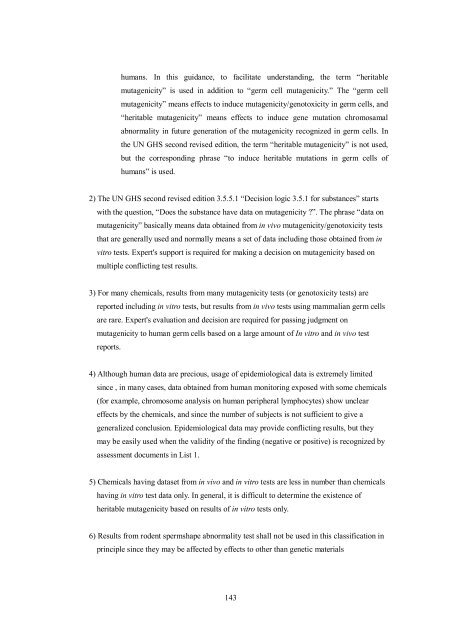GHS Classification Guidance for the Japanese Government
GHS Classification Guidance for the Japanese Government
GHS Classification Guidance for the Japanese Government
You also want an ePaper? Increase the reach of your titles
YUMPU automatically turns print PDFs into web optimized ePapers that Google loves.
humans. In this guidance, to facilitate understanding, <strong>the</strong> term “heritable<br />
mutagenicity” is used in addition to “germ cell mutagenicity.” The “germ cell<br />
mutagenicity” means effects to induce mutagenicity/genotoxicity in germ cells, and<br />
“heritable mutagenicity” means effects to induce gene mutation chromosamal<br />
abnormality in future generation of <strong>the</strong> mutagenicity recognized in germ cells. In<br />
<strong>the</strong> UN <strong>GHS</strong> second revised edition, <strong>the</strong> term “heritable mutagenicity” is not used,<br />
but <strong>the</strong> corresponding phrase “to induce heritable mutations in germ cells of<br />
humans” is used.<br />
2) The UN <strong>GHS</strong> second revised edition 3.5.5.1 “Decision logic 3.5.1 <strong>for</strong> substances” starts<br />
with <strong>the</strong> question, “Does <strong>the</strong> substance have data on mutagenicity ?”. The phrase “data on<br />
mutagenicity” basically means data obtained from in vivo mutagenicity/genotoxicity tests<br />
that are generally used and normally means a set of data including those obtained from in<br />
vitro tests. Expert's support is required <strong>for</strong> making a decision on mutagenicity based on<br />
multiple conflicting test results.<br />
3) For many chemicals, results from many mutagenicity tests (or genotoxicity tests) are<br />
reported including in vitro tests, but results from in vivo tests using mammalian germ cells<br />
are rare. Expert's evaluation and decision are required <strong>for</strong> passing judgment on<br />
mutagenicity to human germ cells based on a large amount of In vitro and in vivo test<br />
reports.<br />
4) Although human data are precious, usage of epidemiological data is extremely limited<br />
since , in many cases, data obtained from human monitoring exposed with some chemicals<br />
(<strong>for</strong> example, chromosome analysis on human peripheral lymphocytes) show unclear<br />
effects by <strong>the</strong> chemicals, and since <strong>the</strong> number of subjects is not sufficient to give a<br />
generalized conclusion. Epidemiological data may provide conflicting results, but <strong>the</strong>y<br />
may be easily used when <strong>the</strong> validity of <strong>the</strong> finding (negative or positive) is recognized by<br />
assessment documents in List 1.<br />
5) Chemicals having dataset from in vivo and in vitro tests are less in number than chemicals<br />
having in vitro test data only. In general, it is difficult to determine <strong>the</strong> existence of<br />
heritable mutagenicity based on results of in vitro tests only.<br />
6) Results from rodent spermshape abnormality test shall not be used in this classification in<br />
principle since <strong>the</strong>y may be affected by effects to o<strong>the</strong>r than genetic materials<br />
143
















